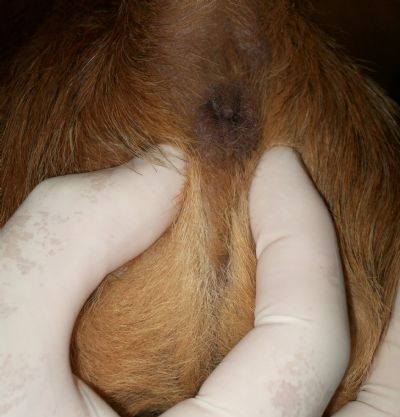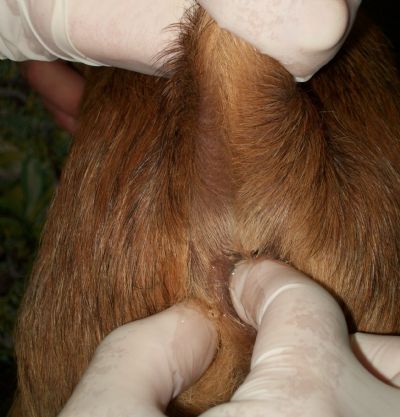Ask Dr Iain-Anal Glands
If you have an animal health question please contact Dr. Iain at
Dear Dr. Iain
I am forever taking my Griffons to the vet to get their anal glands squeezed. I try and keep their diets consistent which is high in fibre and roughage, but it seems to constantly occur. Is it possible to express them myself rather than pay $25 every time I go to the vet? I feel like I'm getting ripped off for something I may be able to do myself. Is it safe to do? Can I cause damage by expressing them myself? How do I know if they're infected because sometimes the smell and colour is very different when the vet does it. What is the normal colour and smell? Can I get them removed? What are the pros and cons for such surgery? Do dogs really need them now?
I hope you can help and any advice would be appreciated.
Thankyou
Caitlyn
Thank you for the comprehensive question, Cate.
Frequently vets will be asked by clients to give their dog a worming tablet because they have been dragging their backside along the ground and as much as we like to sell worming tablets it is only rarely that worms are responsible. Usually it is because the anal gland ducts have become blocked that is the culprit for the dog to be ‘scooting’.
Anal glands a.k.a. anal sacs. Fortunately we don’t have them, but dogs and cats do. They have a territorial scent marking and possibly an anal lubricant function. They probably aren’t as important nowadays and dogs can manage quite well without them but we rarely would recommend their removal for reasons I’ll go into later. If you imagine your dog’s anus as a clock face (not a digital clock Cate !), then the two anal glands are positioned at 4 and 8 o’clock with their respective ducts just opening inside the anus. Some dogs are just prone to these ducts becoming blocked and toy breed dogs are very commonly affected. However, a common contributing factor is the dog not getting adequate dietary fibre such as dry food or vegetables, that provide bulk to the faeces that allow them to properly squeeze and discharge the glands when they defaecate. If the glands aren’t discharged then they become bigger and bigger. Your dog becomes uncomfortable and will scoot or otherwise lick and chew at their anus and so get anal gland breath! Sometimes their attempts will successfully express the glands for themselves but if they aren’t then you run the risk of an anal gland abscess forming which will eventually burst and discharge yucky bloody exudate. You don’t want to wait this long!
You can choose not to pay your vet to express the anal glands and attempt to DIY and save some dollars. So instead of pulling a face, put a disposable glove (e.g. Ansell brand gloves) on one hand and have someone help by holding your dogs’ head. Place thumb and forefinger either side and just below the anal opening at the 4 and 8 o’clock positions. If the glands are full you will feel two firm bubbles underneath the hairless skin, in a Griffon a very full gland might feel like a small marble in size. The fuller the gland is, the harder it will feel. Now pinch IN and SQUEEZE your thumb and finger TOWARDS EACH OTHER.

It can be uncomfortable to your pet and they may struggle and yelp but it’s better out than left in! If the discharge is blood tinged and expression is really painful and one or both glands is really hard and enlarged then the gland/s may be infected and so your dog should visit the vet for treatment.
Another hint is to stand to the side rather than directly behind your dog because sometimes the anal gland secretion can discharge with a jet like intensity. Also have a wad of cotton wool positioned over the anus to wipe up the discharge that varies from pale yellow or green to brown, grey or black in colour and from watery to thick granular sludge in consistency but always has a strong pungent musky smell. Some dogs that are overweight will have an anus that is abit recessed and so it’s difficult to get thumb and fingertip behind the glands to squeeze. Here it becomes alittle gynaecological but you need to lubricate the tip of your gloved index finger (e.g. KY jelly) and insert it gently into the anus no deeper than about the first finger joint and with the tip of this finger on the inside of the anus and your thumb on the outside you squeeze out each gland separately (see photo where I'm expressing the left anal gland)

How often to express? Whenever your dog is scooting or licking at their anus. I’ll also express my dog’s glands when they are having a bath and so easily wash away any discharge and smell. Some dogs never need expression but those that regularly do may benefit with a dietary adjustment. Higher fibre content foods such as dry food, vegetables and cereals instead of canned food, meat and too many bones are recommended. The glands will refill within a couple of days but will normally be discharged at defecation.
Dogs that repeatedly get anal gland abscesses can be considered to undergo anal gland removal. However, some dogs can suffer permanent damage to their anal sphincter after this surgery and so we don’t recommend it unless it really seems necessary.
Good luck and I am always available to demonstrate the technique at dog shows for a $35 fee!
Iain Mitchell B.V.Sc (Hons), M.A.C.V.Sc.
Contact Details
President: Mrs Colleen De Haan [email protected]
Secretary -Mrs Robin Simpson [email protected]
